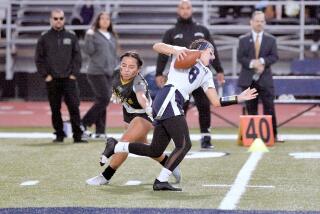DAY TRIPPER : After Uphill Battle to Build Aerial Tramway, Things Are Looking Up
If you live in Southern California, there are basically two ways to observe all the climate zones from Sonoran Desert to Arctic Fringe. You either can take a motor trip from Mexico to Alaska, or you can take Highway 111 to the Palm Springs Aerial Tramway and ride the tram from the Valley Station to the Mountain Station at 8,516 feet above sea level.
Travel time from Orange County to the Valley Station is about 1 1/2 hours, and the tram ride takes 14 minutes. The Alaskan jaunt takes somewhat longer.
Making its way up almost 6,000 feet from the yuccas and creosote to the evergreens and firs of the 13,000-acre Mt. San Jacinto State Wilderness, the tram offers a dramatic--downright heart-stopping for those sensitive to heights--2 1/2-mile cable ride featuring unbeatable views of the Coachella Valley.
The tram celebrates its 30th anniversary of operation this month. But the idea for a tramway up the sheer cliffs of Chino Canyon actually was conceived almost 60 years ago, in 1935, when the late Francis Crocker, on a trip to Banning, looked up at snow-capped Mt. San Jacinto in the heat of the day. According to the tram’s resident historian, 18-year-employee Linda Vivian, the operation proved an uphill struggle ever since.
“A tremendous struggle,” Vivian said. “When you propose putting up a mechanical device to enter a state park, there’s going to be resistance. Creating an authority to oversee the tram literally took an act of legislation.
“Back in the 1930s and ‘40s, the tram was a not-going-to-make-it kind of thing,” Vivian said. “Once opened, it still did not do well for several years. It wasn’t until 1988 that we ever made a payment toward the principal.”
Things are looking up, so to speak.
Indeed, the tram’s 30th anniversary also marks a fiscal milestone. During the 20th anniversary, the project became current with interest payments for the $8.5 million raised from private investors for construction. The first payment on principal was made during the 25th anniversary, and this year, the tramway caught up with those payments as well.
Initially dubbed “Crocker’s Folly,” the tramway has been designated an historical civil engineering landmark for the ingenious use of helicopters in erecting the supporting towers. Five Bell helicopters flew 23,000 “missions” during 26 months of construction.
The first tower is the tallest, at 214 feet. One ascending tram counterbalances a simultaneously descending tram, each with 80-passenger capacity. Each of the large track cables on which the trams ride is 13,500 feet long and weighs 61 tons, and all told there is more than 27 miles of cable.
About 200 visitors rode the tram in 1963. Almost 10 million have ridden in the 29 years since. The majority are sightseers. Many opt for the Ride ‘n’ Dine combination (offered daily after 4 p.m.) which includes a cafeteria-style dinner at the Alpine Restaurant.
For hikers and backpackers, the Mountain Station at the top is not the destination but rather a departure point.
The wilderness--the only area in Southern California so designated--includes 54 miles of trails that range from a one-mile nature walk, or 25-minute mule ride ($7), through picturesque Long Valley to the inspiring 13-mile trek to the 10,804-foot summit of San Jacinto and back, certainly one of the most beautiful hikes in Southern California.
A permit (no charge) is required for any hiking or backpacking in the wilderness and is easily obtained at the Long Valley ranger station. Eleven primitive campgrounds fill up quickly on weekends.
In the winter, the top of the tramway is transformed into a pristine hub for cross-country skiers, snowshoers and even snow campers. Ski and snowshoe rentals are available at the Nordic Ski Center from mid-November until mid-April.
Cars depart at least every half hour from 10 a.m. Monday through Friday, and from 8 a.m. on weekends and holidays. Last car up is 9 p.m., last car down 10:45 p.m. (one hour earlier November to April). Tram prices are $15.95 for adults, $9.95 for children; Ride ‘n’ Dine combination, $17.95.
From Orange County, take the Riverside (91) Freeway north to the Pomona (60) Freeway east. Take Interstate 10 east, then Highway 111 toward Palm Springs to Tramway Road and turn right. The Palm Springs Aerial Tramway is located up the hill at One Tramway Road. Call (619) 325-1449 for more information.
More to Read
Sign up for The Wild
We’ll help you find the best places to hike, bike and run, as well as the perfect silent spots for meditation and yoga.
You may occasionally receive promotional content from the Los Angeles Times.






